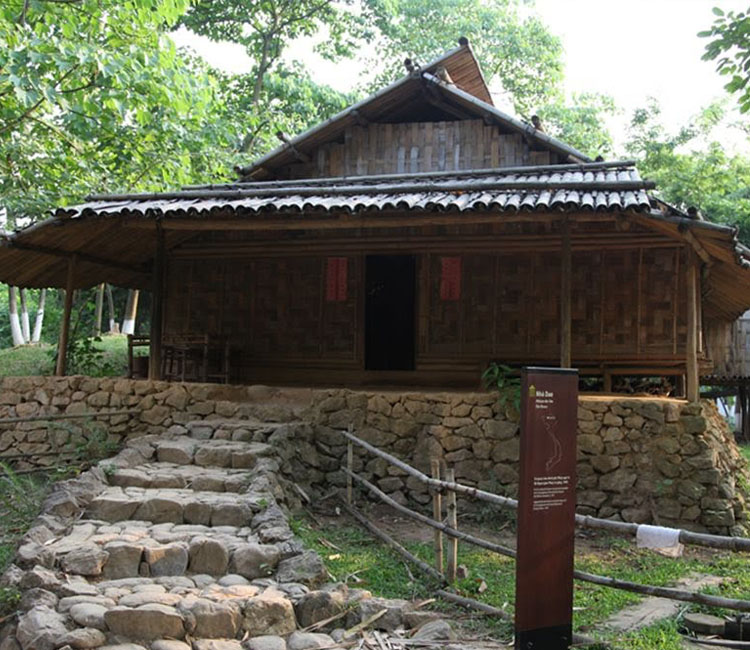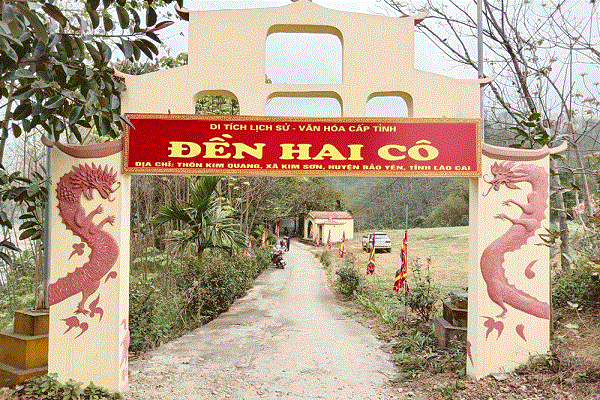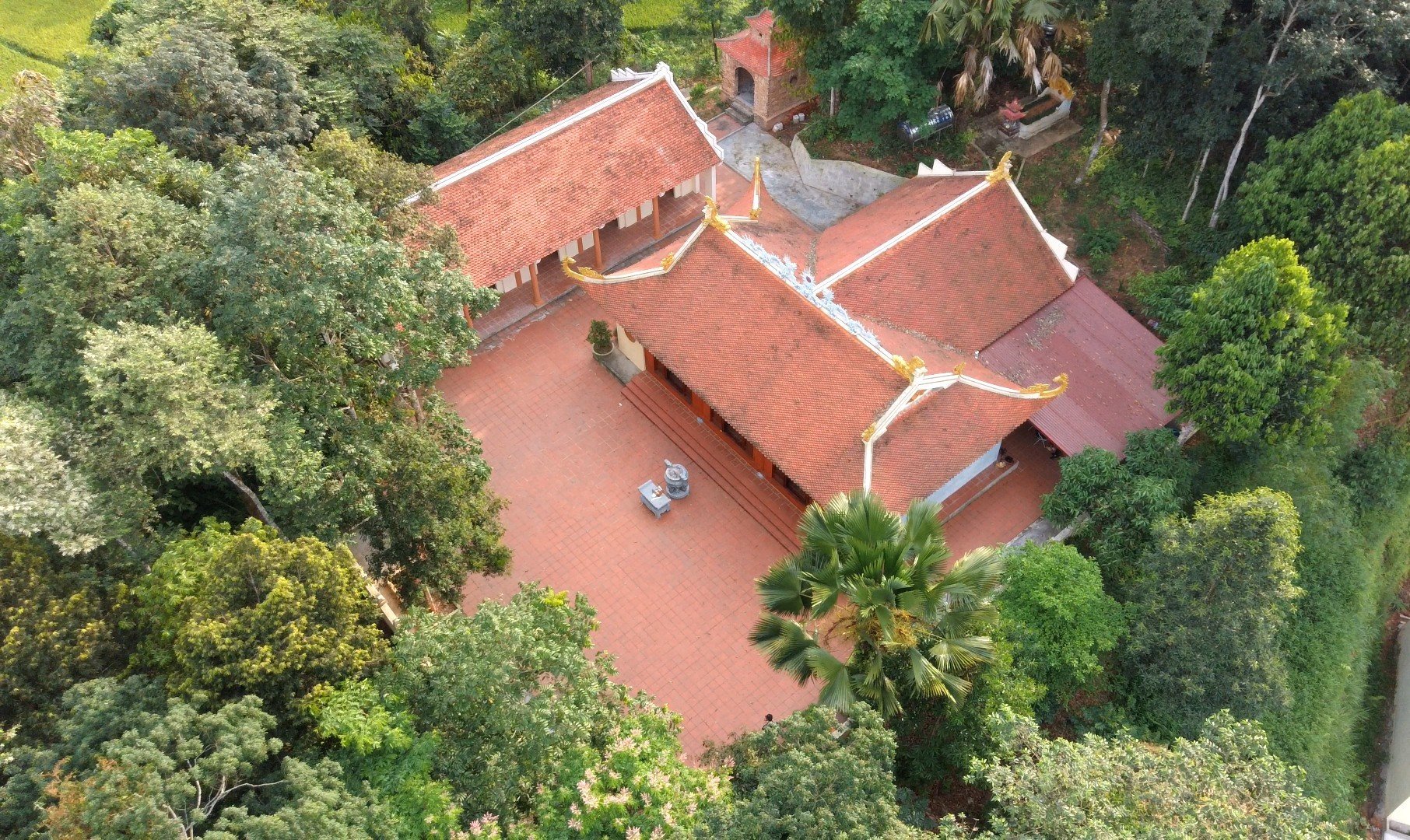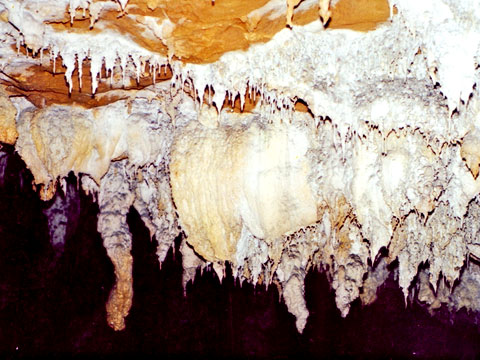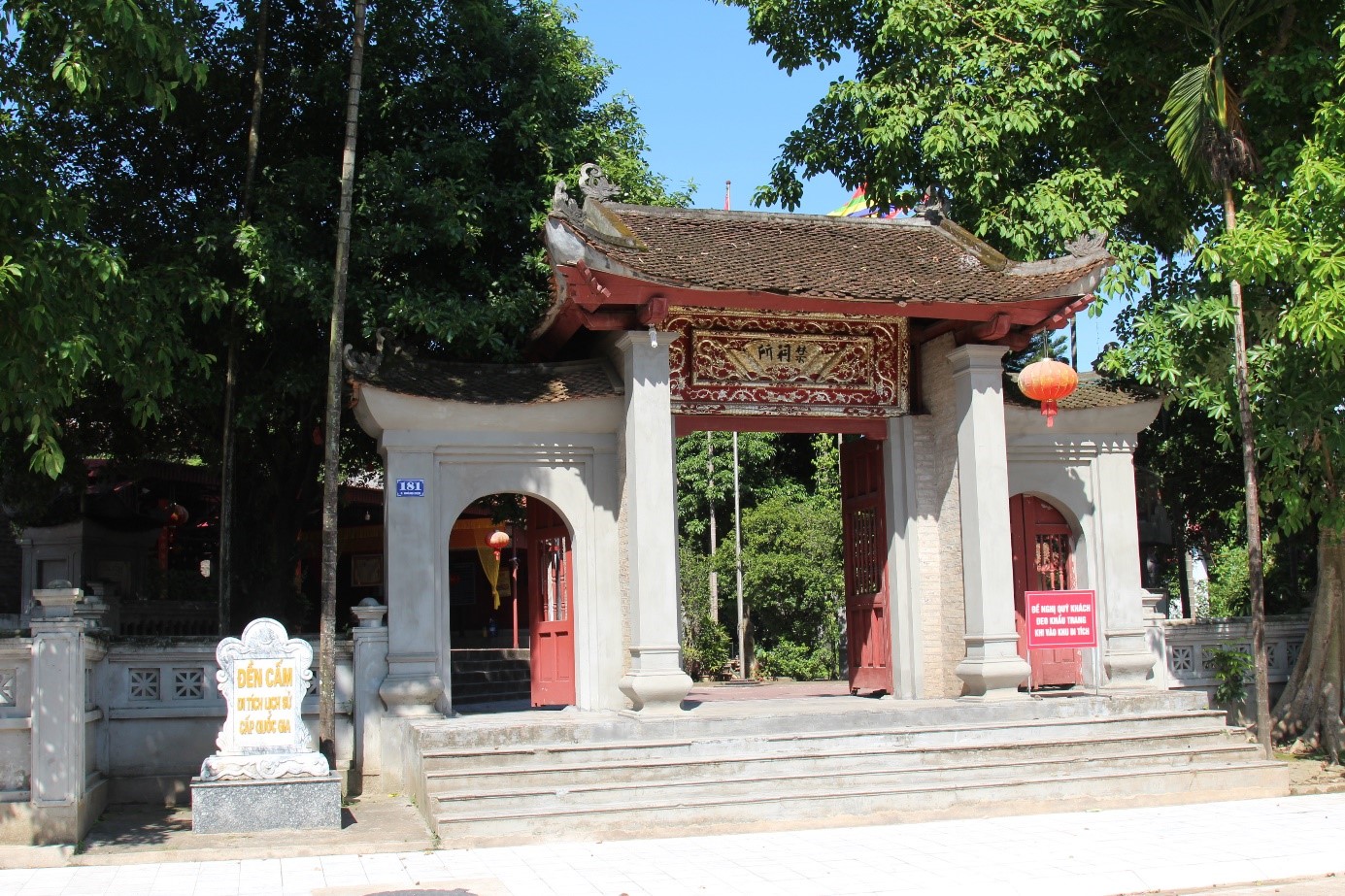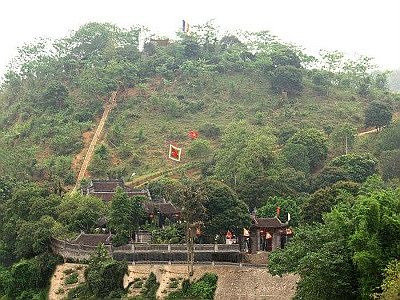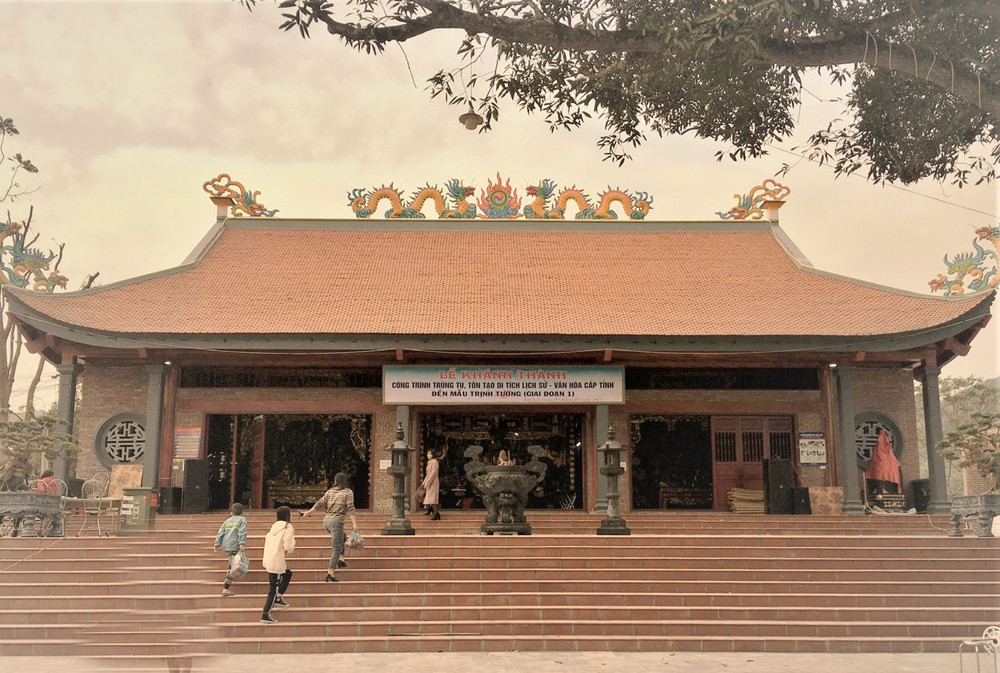Relic point Vietnam
Việt NamPit Temple - Luong Son
For a long time, in the spiritual life of the Tay people, the temple has been a sacred place to worship King Hung, where the belief of worshiping Hung King is practiced. The uniqueness of the temple is the interference of culture and beliefs between the lowlands and the uplands, crystallizing beautiful human values. That is Pit temple in Tay Pit village, Luong Son commune (Bao Yen - Lao Cai). After the Taiping Rebellion in China failed, many remnants fled to Vietnam. Among them, the remaining army group led by Luu Vinh Phuc pulled back to Luc Yen and established the Black Flag army. To feed the remnants of their army, they ordered local officials to pay them food and conscripted young men to join their army. People's lives are extremely miserable. In 1872, the Yellow Flag enemy led by Hoang Sung Anh moved from Yunnan to Lao Cai. A fierce battle between the Black Flag army and the Yellow Flag army caused the people in the area to fall into an extremely tragic situation. The invaders in the border areas were not yet at peace, then in 1885, the French colonialists attacked the northern mountainous provinces. From then on, our nation fell into misery, the country lost its homes, and innocent people suffered many layers of oppression and exploitation. Under many layers of oppression and exploitation that lasted from the late 19th century to the early 20th century, the lives of the people of all ethnic groups in Luong Son were extremely dark. It's no surprise that people need a spiritual anchor. After many times asking high-ranking people to search, reputable people in the Tay community in Ban Pit decided to bring incense sticks to worship King Hung Vuong in Bach Hac, Phu Tho to worship at the temple. Since receiving incense sticks to worship the Hung Kings, the lives of the people of Pit village, Luong Son commune have been spiritually supported and encouraged. The worship of King Hung along with the village's mountain gods and natives has been maintained from that time until today. Pit Temple is located on a land area of over 4000m2, open space, in front are 2 terraced yards of about 300m2, the base of the monument is 50cm higher than the yard level, trees and surrounding terraced fields create a picturesque scene. love. Currently, Pit Temple is a wooden house with 1 main compartment and 2 wings made of wood, the materials are very good, the technical elements meet basic aesthetics. The temple faces East. In the temple there is an ancient incense bowl, the entire stone foundation, and traces of the temple's construction still remain. Many years ago, on the temple festival in January, the women often made a tray of fruit and swallows. At the end of the ritual of worshiping and receiving good fortune, the elders went to a field to throw rings, play swallows, play spinning... All men and women, old and young, were excited and excited, their spirits were sublimated. Have a new year with much joy. Once played, the shuttlecocks will be kept at the shaman's family until next year, when a new one will be made and the old one transformed. With its multifaceted values, Pit Temple has been ranked a provincial historical relic by the Lao Cai Provincial People's Committee. Pit Temple in Luong Son commune is a spiritual address, space for cultural and religious activities of ethnic minorities here. In particular, the temple is associated with the belief of worshiping Hung Kings - an intangible cultural heritage of humanity. The temple is a testament to the interaction of Tay - Vietnamese culture. Pit Temple is a spiritual highlight in the local spiritual tourism development roadmap. SOURCE: Ministry of Culture, Sports and Tourism
Lao Cai 2758 view
Hai Co Temple - Kim Son
Coming to Bao Yen, tourists follow the Noi Bai - Lao Cai Highway; Hanoi - Lao Cai Railway, or National Highway 70, National Highway 279, convenient transportation brings tourists to the National Historical and Cultural Monument Bao Ha Temple, worshiping the name of General Hoang Bay, a famous sacred temple. national language; Co Tan An Temple, a national historical and cultural relic, is located across the Red River, opposite Bao Ha Temple, worshiping Miss Thuong Ngan (Nguyen Hoang Ba Xa) who has meritorious service with her father, "God of National Defense Hoang Bay". fight the enemy and protect the Fatherland's borders. Also from here, visitors come to Kim Son commune, a peaceful, prosperous countryside next to the red Red River heavy with silt, where there is Hai Co Temple located on a high hill reflecting on the River, a beautiful landscape. "Mountains, water, love". After a period of time when scientific historical researchers learned about the history of the Tran Dynasty, two girls followed the Tran Dynasty's army to fight the Yuan-Mongol invaders in the 13th century, and heroically sacrificed their lives at Bai Bai land. Sickle, now Quang Kim village, Kim Son commune, Bao Yen. On December 28, 2018, Lao Cai Provincial People's Committee issued Decision No. 4349/QD-UBND on classifying Hai Co Temple Relics as a provincial-level cultural and historical relic. The legend of Hai Co Temple was recorded by historians: According to the words of the elders in Kim Quang village and the remaining artifacts of the temple show; Hai Co Temple has a history of more than a hundred years ago with many layers of folk sediments passed down about the characters worshiped in the temple. The story of the worshiped figure and the history of the Temple has only been passed down from generation to generation through oral stories among the people and to this day only a few old people still remember. Ms. Le Thi Nhang - Hai Co temple incense maker said: In 1965, there were still 4 Dao families living in Bai Liem village. She heard the older Dao people tell about the characters worshiped in the temple, Hai. She contributed to this land in the resistance war against the Yuan-Mongol army during the Tran Dynasty. Legend has it: During a battle with the Yuan-Mongol army (13th century), two girls followed the Tran Dynasty army and guarded a high hut at Bai Liem to light a fire to signal when the enemy was coming. . In this battle, the enemy was very strong and attacked like a storm, the Two Girls' watchtower was surrounded by the enemy on all four sides. Knowing they could not escape the siege and determined not to fall into the hands of the enemy, Hai Co set fire to the guard tower and committed suicide. After the two waterfalls appeared in the Bai Liem area. Hai Co's soul appeared many times to assist Tran Dynasty soldiers at that time in winning many battles against the invading Yuan and Mongol armies. That is why the prestige and sacredness of Hai Co is famous far and wide. To commemorate the sacrifices of the Two Girls, the people here built a Temple to worship and often call it "Hai Co Temple", the temple worshiping the Two Girls who heroically sacrificed in the battle against the Yuan - Mongol invaders. Protect the borders of the land of Kim Son people in particular and the Vietnamese people in general. Today, people here often think: The two ladies often appear to bless and protect the boats traveling on the Red River to sail smoothly. On the 1st day, the full moon day, at the beginning of spring, people come to offer incense and flowers at Temple Co, praying for "the accident to pass, the accident to be cured, everyone to be healthy, the family to be warm and peaceful, and the crops to be lush..." Hai Co Temple is located in Kim Quang village, Kim Son commune, Bao Yen district, Lao Cai province. This place is still called Liem beach, a promontory protruding into the Red River surrounded by large, green, shady trees all year round. Hai Co Temple is located on a high hill, not adjacent to houses, on both left banks adjacent to the Red River, behind the Temple is adjacent to Provincial Road 161. To meet the spiritual needs and tradition of "drinking water, remember the source" of local people and tourists from everywhere; Currently, the People's Committee of Bao Yen district is planning to expand the land fund and embellish the temple grounds, so that people and local authorities can conveniently preserve and promote the value of the temple's provincial-level historical and cultural relics. Hai Miss./. ELECTRONIC INFORMATION PORTAL OF BAO YEN DISTRICT, LAO CAI PROVINCE
Lao Cai 2708 view
Long Khanh Temple
Long Khanh Temple Cultural and Historical Relic, Phuc Khanh Commune, Bao Yen District, Lao Cai Province organized the Long Khanh Temple Festival with two parts. During the ceremony, delegates, residents and tourists participated in the procession. Carrying a palanquin and offering incense according to the customs and culture of the Nung ethnic group (the majority ethnic group here), praying for good rain, peaceful winds, lush and bountiful crops, and a prosperous and happy family. At the festival, local people and tourists can experience folk games such as tug of war, blindfolded duck catching, rice cooking competitions, baking competitions, singing and dancing... performances and games imbued with identity of the people here. According to historical records, at the end of the 19th century, Luc Yen was invaded by black flag rebels from the north, looting wealth, killing civilians, and burning houses. Not giving up in the face of misery, the mandarin of Luc Yen province at that time was Tang Han Bao, he was teacher Tao, a very prestigious Nung ethnic person, and gathered a large number of people in the area of the same clan to stand up and rebel. . In order to commemorate the merits of the hero Tang Han Bao who sacrificed bravely and heroically, the local Chief Minister presented to King Khai Dinh (Nguyen Dynasty) asking for approval to worship in the entire region on the 2nd day of the lunar month. January every year. The main festival of Long Khanh Temple on July 10 (lunar calendar) every year attracts many locals and tourists from everywhere to worship and pray for blessings, fortune, and wealth. In 2018, Historical and Cultural Relics d SOURCE: ENVIRONMENTAL ECONOMICS ELECTRONIC MAGAZINE
Lao Cai 2637 view
Nghia Do Temple
According to historical records: Ancient Nghia Do was a large valley with rich forest land, surrounded by streams, creating a peaceful landscape. In the late 18th and early 19th centuries, this place was called "Muong Khuong", later renamed "Muong Nghia Do" associated with the formation of Nghia Do temple on July 14, Canh Tuat year, year of Tu. Third Germany (1850). The name Nghia Do has been associated with this land ever since. Here, brothers Vu Van Uyen, Vu Van Mat (the Bau lords) and a number of generals of the Vu family and generals in the region built a defense line to protect Nghi Lang citadel from afar; Organize land reclamation to serve local military food production, expand and develop this land. In particular, the Bau lords allowed lowland soldiers to integrate with the indigenous people to create permanent garrisons on the border region. Nghia Do Temple has been recognized as a provincial-level historical and cultural relic since 2016. In 2018, the temple was embellished and restored; By 2019, it will be inaugurated and put into use, meeting the spiritual needs of people in the region and tourists from everywhere. Nghia Do Temple Festival is held annually on July 14 (lunar calendar) to commemorate the great contributions of the Bau lords hundreds of years ago who protected the peaceful life of the people and expanded development. this land. Lao Cai electronic newspaper
Lao Cai 2668 view
Pho Rang station
(CPV) - Pho Rang Fort National Historical Site in Pho Rang town, Bao Yen district (Lao Cai) is a special testament, where the heroic and glorious historical victory of the 73rd generation of ancestors is engraved. years ago (June 26, 1949 – June 26, 2022). According to the History of Bao Yen District Party Committee (Lao Cai), Pho Rang station was built on peak 442, with an area of nearly 1 hectare; This is a strategic location, able to control the entire basin area of Pho Rang town and surrounding areas. The station has almost three sides of the river, so the station can cover and monitor all activities on the river and both sides of the river. The French built a solid fortification system with many bunkers, trenches, dense sharpened bamboo fences around the base, mines, obstacles and gun emplacements were arranged around the station. The enemy also arranged 2 platoons of European and African soldiers, 1 team of red soldiers, 1 platoon of paratroopers, 1 platoon of soldiers, all kinds of weapons ready to fight back and block the progress of our military branches to liberate the region. Northwest. On May 19, 1949, the Thao River campaign opened, our troops destroyed two positions, Dai Buc and Dai Phac (Tran Yen district, Yen Bai) in Nghia Lo subdivision, shaking the entire defense system. of the enemy on the right bank of the Red River in Yen Bai province. Taking advantage of the victory, we attacked the Pho Rang sub-area, which was a key base, the enemy's headquarters and also the sub-area's headquarters. At 6:00 p.m. on June 24, 1949, our artillery began firing at the enemy post, suppressing the gun emplacements. After more than 40 hours of continuous fighting with intense, resilient and courageous spirit, at exactly 08:00 on June 26, 1949, our troops took control of the battlefield, defeated the post, and captured alive the Ba commander. station, destroying more than one enemy company. Pho Rang post was defeated, a part of the enemy army retreated in two directions toward Nghia Do and Lao Cai. The destruction of Pho Rang command post shook the enemy's defense line from Pho Lu to Nghia Do, causing losses, confusion and fear to the enemy. The victory at Pho Rang post broke an important link in the defense line of Bao Ha - Pho Rang - Nghia Do - Yen Binh, promoting the disintegration of the enemy, creating a premise for the main force to advance to liberate Pho Lu and advanced to attack Nghia Do post, making an important contribution to bringing the Song Thao campaign to victory, smashing the enemy's key defense line, liberating over 600 square kilometers and tens of thousands of people from the Northwest ethnic groups to escape the yoke. enemy's grip. The Battle of Pho Rang Fort was a heroic and glorious victory that was recorded in the glorious history of our country. On June 11, 1999, Pho Rang Fort relic was recognized by the Ministry of Culture and Information (now the Ministry of Culture, Sports and Tourism) as a National Historical Relic, according to Decision No. 38/QD-BVHTT . SOURCE: Central Agency of the Communist Party of Vietnam
Lao Cai 2579 view
Ham Rong Cave
Ham Rong Cave is located right at the foot of Ham Rong mountain, Na Bu village, Tung Chung Pho commune, Muong Khuong district, Lao Cai City (now Muong Khuong town) nearly 2km from the district center. This is a large cave located in the heart of a limestone mountain. The reason it is called Ham Rong is because according to legends and folk tales, in the cave there is a very large dragon that often appears when the weather changes. Therefore, local people named that cave Ham Rong cave. Coming to Ham Rong cave, visitors will have the opportunity to admire the mysterious beauty amidst a vast mountainous area. The road to Ham Rong cave is quite convenient, visitors follow the Tung Lau stream to the main entrance to the cave. This stream curves all year round over each ravine, passes through caves, forming the "Pao Tung" waterfall - a wonderful landscape of the entire Muong Khuong region. Ham Rong cave complex includes 2 main caves connected to each other with a total length of about 750m. Ham Rong cave entrance is more than 6m wide and the cave arch is 5m high, so it is convenient for tourists to visit. The inside of the cave is divided into many small interconnected niches, about 10m deep to reach single dark-colored stalactites, continue up through a small hole - a place to receive natural light that shines deep into the cave. The strange shapes are: stalactites clinging to the cliffs with dome caves that look soft like climbing gourds. Going deeper into the cave, visitors will see shapes that look like goats eating. grass, shapes of birds in flight, they blend with the landscape shimmering under the lights. Suddenly before the visitors' eyes appeared a palace with the Emperor's crown dotted with sparkling jewels, then shapes resembling successive terraced fields. In the middle of the cave is a round cylindrical block with a head like a Buddha and a kind face, but its body is thorny and rough, clinging to each other like antennae, in some places it looks like a fairy chess board, like a princess's chamber. Lord... The deeper you go into the cave, the more you realize the splendid majesty with the variety of colors creating a poetic and lyrical beauty. Ham Rong Cave has great value in terms of tourism, geology, and aesthetics. Coming to the cave, visitors can not only admire the charming scenery of mountains, forests, natural rivers and streams, but also provide conditions for researchers in geography, soil and stratigraphy. Ham Rong is also a source of artistic inspiration for artists and photographers. Ham Rong Cave was recognized by the state as a National Scenic Monument according to Decision No. 15/QD-BVHTT dated April 14, 2003. SOURCE: Lao Cai Provincial People's Committee
Lao Cai 2564 view
Muong Vi Cave
28 km northwest of Lao Cai city through Bat Xat district to Ban Vuoc, turn left to Muong Vi commune - where there is a large valley, surrounded by rolling limestone mountains forming a complex of caves. Large area called Muong Vi cave complex. This place includes Na Rin, Cam Rang, Cam Rum and Cam Tam caves, all quite beautiful. This is one of the unique and attractive relics of Lao Cai province. Na Rin Cave is a large cave with many transparent silver-colored stalactites interwoven together like simple screens in design but exuding luxurious and pristine beauty. The stalactite heads look like drops of pure water originating from a small stream located on the cave wall. The stalactites look like crystal chandeliers of different sizes. Cam Rang Cave is located halfway up a mountain in a high position with little moisture, the emulsion color is slightly dark brown but solid. Inside the cave are rocks shaped like long gourds and a tray of five yellow fruits that attract the eyes of all tourists coming here to visit and explore. Inside the cave there is a sky gate, above the gate is a stalactite strip that looks like a crown with elaborate iridescent lace strips. Equally attractive are Cam Rum and Cam Tam caves, these two caves also have many rocks with unique shapes covered with colorful stalactites. Cam Tam cave alone contains many rich and attractive folk elements. There are many ancient traces left here, reflecting the spiritual cultural life of the Giay ethnic community. Muong Vi Cave also contains many mystical folk tales about the intelligent and heroic Giay king with his feats of fighting against foreign invaders and protecting his village, such as building streams to prevent water from attacking invaders, planting bamboo to create fences. fought against the enemy very effectively, then came the story of the King's flying stone horse... There are also folk tales telling the story of beautiful and gentle fairies who often come down to help people. during the busy planting and fall seasons planning... Muong Vi cave complex is a large cave complex with many different characteristics and research values, is a place containing rich folk treasures about the country and people here, and is also a place Learn about the research of geologists. In particular, the Muong Vi cave complex has a practical value in the strategy of protecting border security and enriching the local ecological environment. This is also a place to learn about aesthetic values, providing creative inspiration for creative researchers in literature and painting. Currently, this place has been attracting the attention of many scientific fields such as culture, environment, tourism, geology... in order to exploit, conserve and promote the values of relics to serve the people. economic development for the locality. Muong Vi cave complex was recognized by the state as a National Scenic Monument according to Decision No. 38/QD-BVHTT dated June 11, 1999 of the Ministry of Culture and Information. SOURCE: Lao Cai Provincial People's Committee
Lao Cai 2657 view
Cam Temple
Cam Temple is located in Soi Muoi village, Van Hoa commune (now the group of 3 Pho Moi wards - Lao Cai), the temple is located at the foot of a low hill, surrounded by lush fruit trees, in front of the temple are 3 ancient trees: the sycamore tree. , jackfruit trees and jade trees spread shade to the temple, creating an ideal landscape. The temple was built and existed nearly 200 years ago and is associated with the history of building and defending the country of the Vietnamese people in general and Lao Cai ethnic people in particular. The temple has a legend associated with the three times of resistance against the Mongol army under the command of the Tran Dynasty's king, general Tran Quoc Tuan - who was awarded the title "Van Co heroic spirit of the highest class of blessings". . Legend has it that in 1257, Tran Quoc Tuan marched to the border to command the defense against the Mongol invaders (13th century). Many generals fell on this border land. Cam Temple was built to commemorate 5 Tran Dynasty soldiers (names unknown). At that time, the station area (today's Pho Moi) was a dense primeval forest. During an inspection and command of border defense (around 1257), General Tran Quoc Tuan chose the location of the current Cam Temple. Now working as a 2nd line military medical station in border defense. Later in the battles, wounded soldiers were brought back to be treated in this forest. The indigenous people at that time, the Vietnamese, Tay and Giay people, also brought sick people in for military medical care. Then something thrilling happened: at night there was a young girl wearing a blue dress who came to treat everyone. The girl was very good at treating everyone. Everyone who received the medicine was healthy, but the miracle doctor just appeared. at night and not seen during the day. Learning about the local people, the people said that there was no one's child like that. Afterwards, the people and soldiers believed that it was the apparition of the Holy Mother of Heaven helping the army and people to protect the country. Right below Phuong Dinh next to this ancient jackfruit tree are 5 graves of military officers who sacrificed their lives for a great cause. Cam Temple is located in the center of the ancient forest, formerly a small temple created by soldiers and villagers together, then officially started construction into a temple in the 16th century, after many advances. Agarwood still retains some ancient maple trees and jackfruit trees. Today, the temple has been beautifully restored and consists of two parts: the main hall and the harem. Meeting the needs of folk beliefs not only of the city's residents but also of tourists from all over, beautifying old legends - legends of military and civilian love on the border. Cam Temple holds its main festival on the seventh day of the seventh month (lunar calendar) every year, celebrating the death anniversary of 5 Tran Dynasty soldiers. People consider this the death anniversary of "erasing the sins of the dead" for the five soldiers; Therefore, together we contribute rice and meat... to the organization. The ceremony of the relic is organized quite spaciously in order. Besides the ceremony, there is also a fun festival with traditional games such as shuttlecock throwing, swallow fighting... In addition, this place is also the place to organize the annual field festival. On December 27, 2001, Cam Temple was recognized as a National Historical Site according to Decision No. 51/QD-BVHTT of the Ministry of Culture and Information. SOURCE: Lao Cai Provincial People's Committee
Lao Cai 2830 view
Dinh Chieng Ken Lao Cai
Located in the Bao Ha National Temple historical relic complex of Lao Cai province, Ken Temple (Chieng Ken, Van Ban, Lao Cai) is famous for its solemnity and antiquity with valuable evidence still intact. Ken Temple is located on top of Pu Dinh hill, over 180m high, in the heart of Ken village with a land area of over 10,000m2. According to memories from the elders, due to the advantage of a high point and a wide field of view, during the French colonial period, colonial soldiers chose this place as the "key point" for all four villages: Ken, Chieng. , Bo village, Be village around a radius of 4 km. However, they could not hold the station for long before the struggle movement and the increasingly strong development of the Revolutionary Army (at that time called Viet Minh), the colonialists had to flee and return to a peaceful life. for local people. Since then, the sacredness of the temple has been worshiped by the people, because the more the enemy holds this place, the more they lose. According to ancient legend, Ken Temple worships Mr. Nguyen Hoang Long and the generals of the Nguyen family who were instrumental in repelling the enemy and establishing villages in Van Ban district. People in the area remember his merits and the generals of the Nguyen family worshiped and built a temple here. Because the Temple is located on the highest hill in the village, it is also called Ken communal house. Over time, ups and downs of history and wars have caused Ken Temple to be destroyed many times, sometimes it seemed like there was no trace left. Today the road to the Temple has been opened by local people. Modern means of transportation such as cars and motorbikes can reach the place, very convenient for tourists to visit. With its mysterious sacredness spread by word of mouth and beautiful scenery, Ken Temple is increasingly known and attracts more and more visitors from all over to visit and worship. Every year on the 7th day of the first lunar month, Lao Cai province holds the Ken Temple Ceremony to commemorate the merits of Mr. Nguyen Hoang Long and his followers. SOURCE: Vietnam Tourism
Lao Cai 2584 view
Trinh Tuong Mother Temple
Trinh Tuong Mother Temple is a place to worship the Holy Mother Thuong Ngan - the second Holy Mother in the Three Holy Mother Temples, governing the music palace, that is, governing the mountains and forests, guarding the border. Ms. Tran Thi Thanh, incense burner at Mother Goddess Trinh Tuong temple, said: The temple was built in the early 20th century and was ranked as a provincial historical-cultural relic in 2016. In recent years, Bat Xat district has mobilized many resources to restore and embellish monuments, and at the same time manage festival activities well. From the main temple, which was a small 4-level house as a place of worship, up to now, Trinh Tuong Mother Temple has been expanded with the following items: Main temple house, ceremony house, golden temple, Huu vu house, three-entrance gate, crescent lake… Entering Trinh Tuong Mother Temple, visitors feel a quiet, peaceful space with wafting incense smoke and the sound of birds chirping in the ancient trees. Although it has been through periods of renovation, visitors can still see the remaining ancient architecture on each brick, tiled roof or the gilded and lacquered worship statues with a majestic and magnificent appearance. Every year, on the 10th day of the 3rd lunar month, the Trinh Tuong Mother Temple Festival takes place to pray for a year of good rain, good winds, lush crops, and peace in the country and people. The festival is held solemnly, in accordance with the belief of worshiping Mother Goddess Thuong Ngan; exploiting traditional cultural values, creating cultural activities and folk beliefs that are colorful, attractive and suitable to the actual conditions of the locality. Source “Lao Cai Electronic Newspaper
Lao Cai 2604 view
